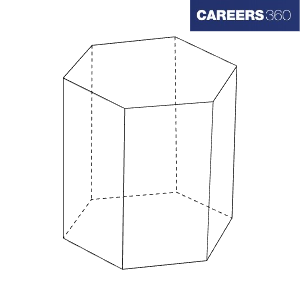How Many Edges Does A Hexagonal Prism Have
A hexagonal Prism has 18 edges. Let us learn in detail about what a hexagonal prism is and some more facts about a hexagonal prism in the following section.
Introduction
A prism is a solid structure in geometry that has flat faces or surfaces, uniform cross-sections along its length, and two identical ends that can be a triangle, square, rectangle, etc. There are no curves in the prism's form. A rectangular prism is one whose cross-section resembles a rectangle. A prism is referred to as a hexagonal prism if its base has a hexagonal form. As a result, bases for prisms other than circular ones include triangular, square, rectangular, pentagonal, and other polygonal shapes. A prism with a hexagonal base and top is known as a hexagonal prism. There are 12 vertices, 18 edges, and 8 faces in a hexagonal prism. Because it has two hexagonal faces and six parallelograms, the object is known as a hexagonal prism. Due to the similarity of a prism's opposite faces, these hexagons are located at the base and top.

Examples from our daily life
Despite not being as prevalent as other prisms, hexagonal prisms are nevertheless all around us. Examples include boxes, nuts, pencils, weights, structures, vases, and more.

Properties of Hexagonal Prism
A hexagonal prism is a prism that has six rectangular faces and two hexagonal bases. A hexagonal prism has the following features:
It contains 12 vertices, 18 edges, and 8 faces.
The lengths of the top and bottom bases are the same.
A regular hexagonal prism's center point is crossed by the diagonals.
All of a hexagon's angles are identical in a standard hexagonal prism.
All of a hexagon's angles differ in an asymmetric hexagonal prism.
The volume of A Hexagonal Prism
A hexagonal prism's volume is the amount of space it takes up. The following equation can be used to get the volume of any prism:
Volume is equal to base x area x prism height.
The polygon base's surface area is referred to as the base area. It is the hexagon in this instance.
Because it refers to the surface area, it is measured in square units (such as square inches or square feet).
The column that joins the prism's two bases is what determines its height. Since it refers to the length of the column, it is expressed in single units (such as inches or feet).
The value that results from multiplying the base area by the height is expressed in cubic units, such as cubic inches, cubic yards, cubic feet, or cubic meters.
The value that results from multiplying the base area by the height is expressed in cubic units, such as cubic inches, cubic yards, cubic feet, or cubic meters. These measurements reflect a three-dimensional object's volume.
Hence, the volume of a regular hexagonal prism can be given by
V = 3√3a2h/2, where, a is the edge of the hexagonal base and h is the height of the prism.
Uniform polyhedron
The hexagonal prism, which has square side faces and two regular polygonal tops, is the fourth in an endless series of prisms; if all of its faces are regular, it is a semiregular polyhedron. It can be visualized as a truncated hexagonal hosohedron, or the Schläfli symbol t2,6. Another way to look at it is as the Cartesian sum of a line segment and a regular hexagon, which is represented by the number 6. The twin of a hexagonal prism is a hexagonal bipyramid.
The geometry group D6h of order 24 is present in a right hexagonal prism. Use is made of rotation group D6 of order 12.
Key Points
A hexagonal prism's base is the hexagon, a polygon with six sides.
Eight sides make up a hexagonal prism, of which two are hexagonal and six are rectangular.
There are 18 edges or 18 sides of a hexagonal prism.
The length of the rectangular sides that join the two hexagonal bases together determines the height of a hexagonal prism. The two hexagonal bases are separated by this path, which is the shortest.
The net of a hexagonal prism is the 2D representation via which the edges of the net are joined to create a hexagonal prism. The faces and sides of the hexagonal prism are visible when the figure is opened flat. With the aid of a net, the hexagon and rectangle in the prism can be viewed.
Applications for Admissions are open.
As per latest syllabus. Physics formulas, equations, & laws of class 11 & 12th chapters
JEE Main Important Chemistry formulas
Get nowAs per latest syllabus. Chemistry formulas, equations, & laws of class 11 & 12th chapters
JEE Main high scoring chapters and topics
Get nowAs per latest 2024 syllabus. Study 40% syllabus and score upto 100% marks in JEE
JEE Main Important Mathematics Formulas
Get nowAs per latest syllabus. Maths formulas, equations, & theorems of class 11 & 12th chapters